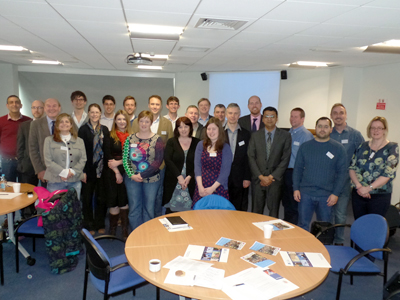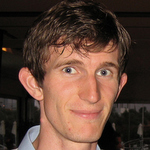Scanning for peace of mind
Posted on 27 May 2015
Scanning for peace of mind
 By Simon Choppin, Software Sustainability Institute Fellow and Research Fellow, Sheffield Hallam University.
By Simon Choppin, Software Sustainability Institute Fellow and Research Fellow, Sheffield Hallam University.
Developments in technology and software are often accompanied by cohorts of enthusiastic developers and engineers who are convinced by its revolutionary potential. However, new technology often requires careful nurturing before it truly changes the way we do things – a number of things have to be working in harmony before the revolution can take place. If you push too hard, and in the wrong direction, things can veer off course and never recover. I wrestled with the nuances of technology and its potential at a seminar for Breast Surface scanning at Ulster University, Belfast.
Three dimensional scanning has a huge variety of applications. The ability to capture your environment as a detailed, 3D surface holds promise at the micro and macro scales. As such, 3D scanners appear on things from self-driving cars to mobile phones. Our interest in 3D scanning came from work in sports and health applications. A collaboration with Mr Amit Goyal, a breast surgeon at Derby Hospitals, meant that we started to apply what we'd learnt scanning athletes to breast cancer and reconstruction. Our current system consists of four Microsoft Kinect depth cameras which not only act as scanners but are available for less than £200 each. In order to transform our Kinects into a usable scanning machine we've developed calibration protocols and a software interface. Each time we take a scan, software captures the 3D data from each device, applies a number of correction and filtering algorithms and transforms data (according to predefined calibration information) so that a single, coherent scan is returned. The data that scanning systems obtain can be used to keep a rich record of a patient's progress and the effects of treatment, tracking changes in volume or shape which wouldn't be possible with simpler measurement tools. In addition, software allows us to visualise these changes intuitively and feed this information back, improving the peace of mind of the patient.
The standard tools for planning breast surgery are a tape measure and pair of callipers. With these the surgeon is able to take simple measurements and assess breast size and shape, but nothing higher dimensional. Technology has a role to play: modern scanners can take an accurate snapshot of a patient's chest in a fraction of a second. The scan can be used to perform simple and in-depth analyses. Complicated metrics like breast volume can be measured accurately and powerful visualisations give a patient a visual record of their treatment and progress – helping with peace of mind.
Given these advantages it is no surprise that researchers are looking into the hardware and software that would drive a 3D analysis system. A number of institutions have been working independently in this area and there is a growing body of research.
The idea for the meeting came about after an informal discussion with Dr John Winder. We both worked with 3D scanning technology and we were both interested in its potential for bringing about change in the treatment of breast cancer. Dr Winder had a number of great contacts who were all involved in this technology in some way: developers, technicians and surgeons – all people who would have a different perspective and outlook. By bringing us all together for one day the meeting aimed to discuss and present the issues and opportunities surrounding this new technology. With funding from the Software Sustainability Institute we were able to invite Dr Helder Oliveira from Porto University as a keynote speaker. His experience working on a large European project on breast imaging gave us a good example of collaborative working to develop imaging tools used by practitioners. For example, while we had been focusing on the accuracy and integrity of our 3D scan information, Helder highlighted the importance of scan aesthetics, the colour and shade of a scan can greatly alter perception. As our colour information was combined from four different devices, shaded fringes appear at interfaces and were something we'd previously dismissed as one of those things. Thankfully, Helder presented a software based solution which can massively improve results.
When organising the seminar we realised that for scanning systems to become routine in clinical practice, the gap between research and routine had to be bridged. Working intensely on algorithms which deal with point-cloud data doesn't provide any particular insight into the challenges faced by surgeons planning treatment. A dialogue is essential to keep a project on track and your goals realistic and useful.
What I realised during the day is that bringing together a collection of advocates isn't necessarily helpful; you need detractors (or at least the unconvinced) to butt up against and test your thinking. One of our industry contributors questioned us during his presentation: scanning technology is relatively mature, it has been widely adopted in other areas of medicine. Why isn't this the case in breast surgery?
It was during an afternoon discussion session that I started to gather my thoughts. I had always looked at work on 3D scanning using the Field of Dreams approach: "Build it and they will come". We are looking at the adaptation of low-cost scanning hardware to breast scanning applications, i.e. if we make this technology cheap enough then surgeons will want to use it. It hadn't occurred to me that if the technology was of sufficient value, surgeons would use it despite the cost. The message we received from surgeons was mixed, one surgeon thought "the technology is great, but I'll carry on using a tape measure thanks very much" while another presented us with a shopping list of desirable features. We need to work with the advocates to help change the mind of the less-convinced. Proving efficacy, ease of use and cost-effectiveness will all help.
Software is part of this picture. It has the ability to repurpose a tool for a different application and it's the platform which allows the same technology to be used in a variety of ways. However, it's important to recognise that having the skills to engineer innovative solutions doesn't mean we have the insight and experience to choose the right problem. Collaboration and communication are essential to keep us on the right track.
I was energised by the seminar which we hope will turn into an annual event (if you're interested in this area don't hesitate to contact me). We will be working together to build more formal relationships which will be required to effectively develop this technology and areas of application.

